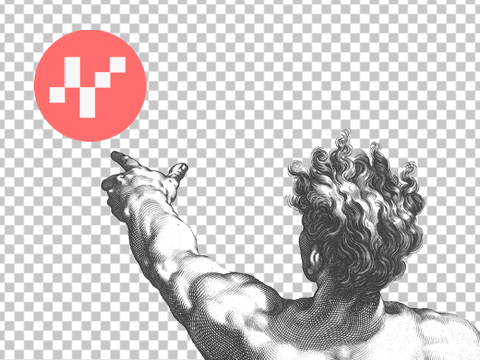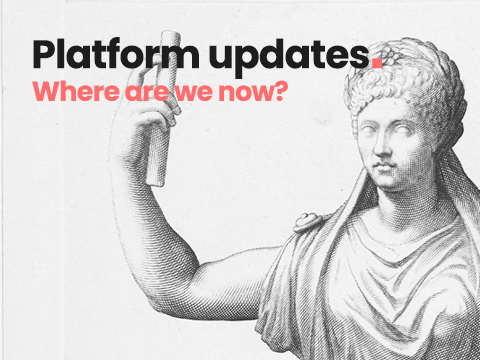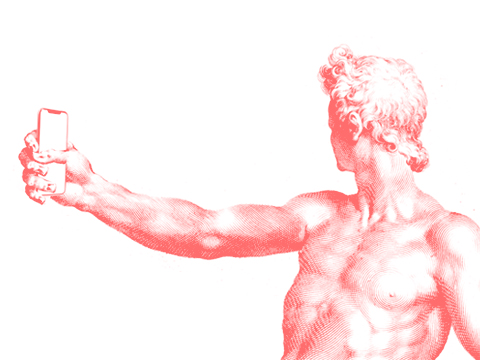Artificial Intelligence: AI a Threat to the Creative Industry?
In the era of digital revolution, Artificial Intelligence (AI) is constantly changing the way we live, work, and create. Despite its numerous benefits, does AI also become a significant threat to the creative industry? Automation and simplification of creative processes. One of the main threats that AI poses to the creative industry is the automation of creative processes. Thanks to machine learning algorithms, AI can generate graphics, music, texts, and much more, leading to the replacement of human creativity with machine-generated content. This, in turn, simplifies the creative processes. At Mateico, we value manual artistic work, the uniqueness of works, and human error, which often contributes to the uniqueness of a particular work. Therefore, we will pay particular attention to ensuring that works are created by artists rather than artificial intelligence. Competition with AI-generated content With the development of generative technology such as GPT (Generative Pre-trained Transformer) or DeepDream, we increasingly observe content created by AI that not only looks authentic but is also difficult to distinguish from human-created content. This puts artists and creative professionals in competition with machines, which may lead to a decrease in demand for their services. But is it really so? At Mateico, we believe that just as MP3 did not
Painting: Discovering the Potential of Expression in Abstraction
Introduction Abstract painting is one of the most fascinating areas of art, enabling artists to express emotions, moods, and ideas through shapes, lines, colors, and textures. In this article, we will delve into the fundamentals of abstract painting and explore several techniques to help you develop your artistic expression. Understanding Abstraction The first step in abstract painting is understanding the concept behind this style. Abstraction allows for the viewer's and artist's interpretation without being confined to realistic depictions of objects, focusing instead on emotional expression and abstract forms. Study works by renowned abstract artists such as Wassily Kandinsky, Jackson Pollock, or Joan Miró to grasp the diversity of approaches to this style. Playing with Colors and Contrasts One of the key elements of abstract painting is colors and their interactions. Experiment with different color palettes, from bright and contrasting to subdued and harmonious. Pay attention to how colors influence each other—what emotions and moods they evoke. Adding contrasting colors can enhance the dynamism of the painting, while harmonious combinations can create a tranquil atmosphere. Textural Techniques Texture plays a significant role in abstract painting, adding depth and complexity to the artwork. Experiment with various tools and techniques such as palette knives, brushes, sponges, or even fingers to
Blockchain: What is Bitcoin halving?
Definition Every four years, the number of bitcoins awarded to miners is halved until all 21 million bitcoins are virtually mined (likely around the year 2140). The halving mechanism helps maintain a scarcity of bitcoin and makes it a hedge against inflation. Despite being a digital currency, Bitcoin cannot be created infinitely. Verifiable scarcity is crucial to its value proposition. Two key concepts regarding scarcity are fundamental to the Bitcoin protocol. Firstly, the number of bitcoins will not exceed 21 million. (By the end of 2020, less than 2.5 million bitcoins remained to be "mined" virtually). Secondly, the number of new bitcoins added to the network will be halved every four years. This latter concept is known as halving. At the beginning of 2020, every 10 minutes, 12.5 new bitcoins were added to the network through virtual "mining". In May, this number halved to 6.25. In 2024, it will decrease to about 3.125, and this process will continue until all 21 million bitcoins are mined (which is estimated to occur around 2140). Around April 16, 2024, there will be another Bitcoin halving, as a result of which the mining reward will drop to 3,125 bitcoin per block. Why is Bitcoin halving important? By emitting fewer bitcoins
Mateico Auctions: Buy and Sell in Traditional and NFT Auctions.
Art has always been a valuable and influential aspect of human culture. Since ancient times, artists have created works that inspire, move, and evoke emotions. Traditional art auctions have been with us for many centuries and are an integral part of the art market. In this article, we will explore the history of major art auctions, the development of auctions in the internet age, and the emergence of NFT auctions. Most importantly, we will provide a brief overview of the auctions we offer on the Mateico platform. Are you curious? Let's dive in. History of Traditional Art Auctions. The existence of traditional art auctions can be traced back to ancient times. Auctions were held in ancient Greece and Rome, where various items, including sculptures and paintings, were sold. However, the true flourishing of art auctions occurred in Europe during the Renaissance period. Auctions became popular in cities like Venice, Florence, and Antwerp, where traders, collectors, and artists had the opportunity to buy and sell works of art. In the 18th and 19th centuries, traditional art auctions became increasingly popular, especially in England and France. This period saw the establishment of renowned auction houses such as Christie's and Sotheby's. These institutions became symbols
Fundraising: Mateico VIP NFT Collection + Token Sale
Dear Mates, We are thrilled to inform you that today, on January 24th, we are embarking on an exciting journey with the launch of our token offering, thanks to the unique Mateico VIP Collection. This exceptional NFT series is a crucial element of our current project fundraising round, aimed at supporting our ongoing development. The concept of NFTs has been designed to provide numerous additional benefits to our community. For investors acquiring NFTs from this collection, we have prepared several additional perks, including: special staking programs, discounts on the platform, access to unique content on the platform and special auctions, as well as exclusive invitations to future events organized by Mateico. additionally, every investor purchasing NFTs from the collection during this fundraising stage will receive the equivalent of the invested amount in $MATE tokens (price: $0.03). Once we surpass $150,000.00, the fundraising will continue for an additional 30 days, after which listing will take place, and the token will no longer be sent together with the NFT collection. Key Information: Buy NFT: https://cifiapp.com/dashboard/microeconomy/nft-drops Name: Mateico VIP Collection NFT Cost: $500 Number of NFTs: 1000 Staking: 20%.+ future programs Price per token: $0.03 (16.666 $MATE) To achieve our goals, we have set three financial milestones: Softcap: $150,000.00 - Platform: - Mateico Gallery & M-art -
Exciting Announcement: 24th January 2024 – Pre Sale of the $MATE Token
Dear Mateico Community, We're thrilled to share a major milestone in Mateico's journey! In collaboration with Circularity Finance, we're hosting the pre sale of the $MATE token on 24th January, 2024. This event signifies a pivotal moment in our commitment to art, technology, creativity, and innovation. Key information: Token Sale Date: 24th January, 2024 Platform: www.circularity.finance Soft Cap: $150,000 Hard Cap: $400,000 Pre-sale price: $0.03 Listing price: $0.1 Pre-sale duration: 30 days Vesting: 3 months vesting What to expect: Mateico.io has chosen the Circularity Finance platform as the venue for the pre-sale. This sale opens up exciting opportunities for art lovers, technology pioneers and investors to become an integral part of the Mateico ecosystem. Why It's Worth Taking Part: Invest in the future of art, culture, and entertainment by acquiring $MATE tokens. Unlock exclusive features, access premium content, take part in art competitions, build a community, contribute to the development of the platform by voting, create history with us. Special Offer: Each investor who takes part in the public sale and the investment is equal to or exceeds $1,000 will receive an NFT from the special Mateico collection, which will enable you to participate in unique auctions, provide access to unique content on the platform, and strengthen your voting power during votes and competitions. How to Participate: Visit
Show your art: Artistic portfolio on the Mateico platform.
A portfolio is a collection of artistic works that serves to showcase an artist's skills, style, and creativity. It acts as an artistic business card, allowing potential clients, art galleries, artistic agencies, and other audiences to explore our creations and evaluate our abilities. A portfolio is an essential tool for artists looking to build their reputation and find new career opportunities. In today's technological advancements and internet-driven world, there are numerous online platforms that facilitate the presentation of portfolios and reaching a broader audience. Examples of such platforms include ArtStation and Behance. These dedicated artist platforms enable easy sharing of artwork, creating professional portfolios, and networking with other artists, clients, and galleries. In today's competitive art world, having a solid portfolio is crucial for every artist. Therefore, on the Mateico platform, artists will also have the opportunity to create their portfolios. A portfolio serves as an artist's calling card and forms the foundation for presenting their work to potential clients, art galleries, artistic agencies, and participants in competitions and exhibitions. Creating and developing a portfolio is a time-consuming and engaging process, but it can be incredibly satisfying and lead to exciting artistic career prospects. In this article, we will discuss the key
Phygital in the World of Museums and Galleries: Mateico AR Application.
In today's dynamic world filled with technological innovations, museums and art galleries are redefining their approach to presentation and audience interaction. The introduction of phygital exhibitions, representing a fascinating blend of physical and digital realities, marks a pivotal milestone in the realms of culture and art. Alongside this development, AR applications like Mateico AR have become indispensable tools that revolutionize how we perceive art and cultural heritage. In this article, we will take a close look at this intriguing phenomenon—phygital exhibitions, and the role of the Mateico AR application, which plays a crucial part in supporting this modern trend. We will explore the benefits and innovations brought by phygital exhibitions, the technologies they introduce to museums and galleries, and how the Mateico AR application transforms the act of visiting exhibitions into an interactive and educational experience. We will also discover how these changes impact various visitor groups, particularly younger generations, opening entirely new doors to the world of art and culture. Join us in delving into the fascinating world of phygital exhibitions and the Mateico AR application, which are reshaping our perspective on cultural heritage and art. Definition of Phygital Exhibitions. Phygital exhibitions, a term derived from the combination of "physical" and "digital,"
Music: Dynamic Microphones. Reliable Sound Companions.
In today's world of audio, microphones are essential tools for capturing, amplifying, and transmitting sound. There are many types of microphones, each with its unique applications and features. One of the most popular types is the dynamic microphone. In this article, we'll take a closer look at dynamic microphones, how they work, and the situations where they are most useful. How Does a Dynamic Microphone Work? A dynamic microphone is an electrodynamic microphone that utilizes a simple yet effective working principle. It consists of three main components: a diaphragm, a coil, and a magnet. When sound reaches the diaphragm of the microphone, it causes the diaphragm to vibrate. These vibrations are transferred to the coil, which is located within the magnetic field of the magnet. As a result, the coil generates an electrical voltage that is proportional to the diaphragm's vibrations. This signal is then sent to an amplifier or mixer, where it can be further processed and recorded. One of the primary advantages of dynamic microphones is their exceptional durability and resistance to damage. Due to their straightforward design, they lack delicate parts like the thin diaphragms found in condenser or electret microphones. As a result, they are more resistant to shocks,
Partnership: Circularity Finance.
We come to you with exciting news! We are entering into a partnership with Circularity Finance! We are thrilled to announce this, and we are one of the first three projects to utilize their tools! Circularity Finance brings powerful tools and wonderful people along with them. ILO and listing are on the horizon, and we can't wait! Website: https://www.circularity.finance/ Telegram group: https://t.me/CircularityFi "X" platform: https://twitter.com/circularityfi Circularity Finance: Redefining DeFi Through Fractionalized Ownership and Innovative Governance. Circularity Finance is a groundbreaking decentralized finance (DeFi) platform that is redefining the possibilities of decentralized technology. At its core, Circularity Finance leverages the power of non-fungible tokens (NFTs) to drive its democratic autonomous organization (DAO) and identify governors within its ecosystem. This innovative approach allows Circularity Finance to offer fractionalized ownership of the platform, giving token holders a vested interest in its success and growth. Moreover, the utilization of NFTs creates a compelling incentive for holders to actively participate in the platform's ongoing development and prosperity. Unlocking Fractionalized Ownership through Blockchain Technology. Fractionalized ownership, such as governance NFTs in the decentralized finance platform, is made achievable through the application of blockchain technology. This revolutionary tech enables the creation of NFTs that represent ownership of specific assets, effectively determining an individual's role










